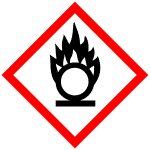13759-83-6
| 中文名 | 硝酸钐六水合物 |
|---|---|
| 英文名 | Samarium nitrate hexahydrate |
| 中文别名 |
水合硝酸钐
硝酸钐 硝酸钐(III),六水合物 硝酸钐(III)六水合物 六水合硝酸钐(III) 六水硝酸钐 |
| 英文别名 |
samarium(3+),trinitrate,hexahydrate
Samarium(3+) nitrate hydrate (1:3:6) EINECS 233-798-6 MFCD00149857 Samarium(Iii) Nitrate Hexahydrate Samarium(III) nitrate hydrate |
| 密度 | 2.375 |
|---|---|
| 沸点 | 83ºC at 760 mmHg |
| 熔点 | 78°C |
| 分子式 | H12N3O15Sm |
| 分子量 | 444.466 |
| 精确质量 | 445.946533 |
| PSA | 262.02000 |
| LogP | 0.46650 |
| 外观性状 | 黄色晶体或结晶粉末 |
| 蒸汽压 | 49.8mmHg at 25°C |
| 储存条件 | 常温密闭,阴凉通风干燥 |
| 稳定性 | 常温常压下稳定 避免的物料 还原剂 易氧化材料 有机材料 金属粉末 |
| 水溶解性 | H2O: 0.1 g/mL, clear |
| 分子结构 | 1、摩尔折射率:无可用的 2、摩尔体积(cm3/mol):无可用的 3、等张比容(90.2K):无可用的 4、表面张力(dyne/cm):无可用的 5、介电常数:无可用的 6、极化率(10-24cm3):无可用的 7、单一同位素质量:445.946542 Da 8、标称质量:446 Da 9、平均质量:444.4664 Da |
| 计算化学 | 1.疏水参数计算参考值(XlogP):无 2.氢键供体数量:6 3.氢键受体数量:15 4.可旋转化学键数量:0 5.互变异构体数量:无 6.拓扑分子极性表面积195 7.重原子数量:19 8.表面电荷:0 9.复杂度:18.8 10.同位素原子数量:0 11.确定原子立构中心数量:0 12.不确定原子立构中心数量:0 13.确定化学键立构中心数量:0 14.不确定化学键立构中心数量:0 15.共价键单元数量:10 |
| 更多 | 1. 性状:黄色无味水晶团粒 2. 密度(g/mL,25/4℃):未确定 3. 相对蒸汽密度(g/mL,空气=1):未确定 4. 熔点(ºC):未确定 5. 沸点(ºC,常压):未确定 6. 沸点(ºC,5.2kPa):未确定 7. 折射率:未确定 8. 闪点(ºC):未确定 9. 比旋光度(º):未确定 10. 自燃点或引燃温度(ºC):不适用的 11. 蒸气压(kPa,25ºC):未确定 12. 饱和蒸气压(kPa,60ºC):未确定 13. 燃烧热(KJ/mol):未确定 14. 临界温度(ºC):未确定 15. 临界压力(KPa):未确定 16. 油水(辛醇/水)分配系数的对数值:未确定 17. 爆炸上限(%,V/V):未确定 18. 爆炸下限(%,V/V):未确定 19. 溶解性:可溶解的 |
|
Section 1: Product Identification Chemical Name:Samarium (III) nitrate hexahydrate (99.9%-Sm) (REO) CAS Registry Number:13759-83-6 Formula:Sm(NO3)3.6H2O EINECS Number:233-797-0 Chemical Family:metal nitrate salts Synonym:Nitric acid, samarium(3+) salt, hexahydrate, Samarium trinitrate hexahydrate
Section 2: Composition and Information on Ingredients IngredientCAS NumberPercentACGIH (TWA)OSHA (PEL) Title Compound13759-83-6100%no datano data Section 3: Hazards Identification Emergency Overview:Irritating to eyes, skin and respiratory tract. May be harmful if swallowed. Primary Routes of Exposure:Ingestion Eye Contact:Causes slight to mild irritation of the eyes Skin Contact:Causes slight to mild irritation of the skin. Inhalation:Irritating to the nose, mucous membranes and respiratory tract. Ingestion:Ingestion may lead to dizziness, abdominal cramps, vomiting, bloody diarrhea, weakness, and convulsions. Acute Health Affects:Irritating to skin, eyes and respiratory tract. Chronic Health Affects:No information available on long-term chronic effects. NTP:No IARC:No OSHA:No SECTION 4: First Aid Measures Immediately flush the eyes with copious amounts of water for at least 10-15 minutes. A victim may need Eye Exposure: assistance in keeping their eye lids open. Get immediate medical attention. Wash the affected area with water. Remove contaminated clothes if necessary. Seek medical assistance if Skin Exposure: irritation persists. Remove the victim to fresh air. Closely monitor the victim for signs of respiratory problems, such as difficulty Inhalation: in breathing, coughing, wheezing, or pain. In such cases seek immediate medical assistance. Seek medical attention immediately. Keep the victim calm. Give the victim water (only if conscious). Induce Ingestion: vomiting only if directed by medical personnel. SECTION 5: Fire Fighting Measures Flash Point:not applicable Autoignition Temperature:none Explosion Limits:none Extinguishing Medium:carbon dioxide, foam or dry powder If this product is involved in a fire, fire fighters should be equipped with a NIOSH approved positive pressure Special Fire Fighting Procedures: self-contained breathing apparatus and full protective clothing. Hazardous Combustion andIf involved in a fire this material may emit irritating fumes. Decomposion Products: Unusual Fire or Explosion Hazards: Metal nitrates can be oxidizers. Contact with strong reducing agents could lead to fires and/or explosions. SECTION 6: Accidental Release Measures Spill and Leak Procedures:Small spills can be mixed with vermiculite or sodium carbonate and swept up. SECTION 7: Handling and Storage Handling and Storage:Store in a tightly sealed container. Keep away from heat and direct sunlight. SECTION 8: Exposure Controls and Personal Protection Eye Protection:Always wear approved safety glasses when handling a chemical substance in the laboratory. Skin Protection:Wear protective clothing and gloves. Ventilation:If possible, handle the material in an efficient fume hood. If ventilation is not available a respirator should be worn. The use of respirators requires a Respiratory Respirator: Protection Program to be in compliance with 29 CFR 1910.134. Ventilation:If possible, handle the material in an efficient fume hood. Additional Protection:No additional protection required. SECTION 9: Physical and Chemical Properties Color and Form:yellow xtl. Molecular Weight:336.37 (444.47) Melting Point:no data Boiling Point:no data Vapor Pressure:not applicable Specific Gravity:no data Odor:none Solubility in Water:very soluble SECTION 10: Stability and Reactivity Stability:hygroscopic Hazardous Polymerization:no hazardous polymerization Contact with strong reducing agents or organic matter. Some nitrates can explode if heated to high Conditions to Avoid: temperatures. Incompatibility:reducing agents, organic matter, phosphorus and sulfur Decomposition Products:nitrogen oxides and samarium salts SECTION 11: Toxicological Information Oral (rat); LD50: 2900 mg/kg. Intraperitoneal (rat); LD50: 285 mg/kg. Intravenous (rat); LD50: 9 mg/kg. RTECS Data:Intraperitoneal (mouse); LD50: 315 mg/kg. Subcutaneous (guinea pig); LDLo: 500 mg/kg. Subcutaneous (frog); LDLo: 1600 mg/kg. Carcinogenic Effects:No data available Mutagenic Effects:No data available Tetratogenic Effects:No data available SECTION 12: Ecological Information Ecological Information:No data available SECTION 13: Disposal Considerations Disposal:Dispose of according to local, state and federal regulations. SECTION 14: Transportation Shipping Name (CFR):Nitrates, Inorganic, N.O.S. Hazard Class (CFR):5.1 Additional Hazard Class (CFR):NA Packaging Group (CFR):II UN ID Number (CFR):UN# 1477 Shipping Name (IATA):Nitrates, Inorganic, N.O.S. Hazard Class (IATA):5.1 Additional Hazard Class (IATA):NA Packaging Group (IATA):II UN ID Number (IATA):UN# 1477 SECTION 15: Regulatory Information TSCA:Not listed in the TSCA inventory. SARA (Title 313):Title Compound: See Category Code N511 for reporting. Second Ingredient:none SECTION 16 - ADDITIONAL INFORMATION N/A |
|
毒理学数据: 1、急性毒性:主要的刺激性影响: 在皮肤上面:刺激皮肤和粘膜; 在眼睛上面:刺激的影响;没有已知的敏化影响。 生态学数据: 通常对水体是稍微有害的,不要将未稀释或大量产品接触地下水,水道或污水系统,未经政府许可勿将材料排入周围环境。 CHEMICAL IDENTIFICATION
HEALTH HAZARD DATAACUTE TOXICITY DATA
|
| 符号 |


GHS03, GHS07 |
|---|---|
| 信号词 | Danger |
| 危害声明 | H272-H315-H319-H335 |
| 警示性声明 | P210-P220-P221-P305 + P351 + P338-P370 + P378 |
| 个人防护装备 | Eyeshields;full-face particle respirator type N100 (US);Gloves;respirator cartridge type N100 (US);type P1 (EN143) respirator filter;type P3 (EN 143) respirator cartridges |
| 危害码 (欧洲) | O: Oxidizing agent; |
| 风险声明 (欧洲) | R8 |
| 安全声明 (欧洲) | S17-S26-S36/37/39-S24/25-S22 |
| 危险品运输编码 | UN 1477 5.1/PG 3 |
| WGK德国 | 2 |
| RTECS号 | VP3150000 |
| 包装等级 | III |
| 危险类别 | 5.1 |
